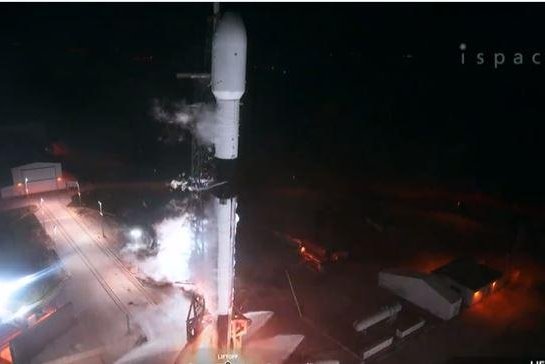
Dec. 11 (UPI) — SpaceX on Sunday morning launched a Falcon 9 rocket from Cape Canaveral with a commercial payload to the moon, a Japanese robotic luner lander and a NASA orbiter to seek signs of water on craters at the poles.
The rocket lifted off from Launch Pad 40 at 2:38.13 a.m. EST. The original launch date 11 days ago was grounded to resolve an unspecified problem with the rocket.
The lsunch Sunday was on the 50th anniversary of the last Apollo moon landing in 1972 and10 hours before NASA’s unpiloted Orion moonship was to splash down in the Pacific Ocean west of Baja California.
Tokyo-based ispace, builder of the Hakuto-R lunar lander, is seeking to develop commercial operations on the moon.
The moon is 238,900 miles from Eartth.
The reusable booster, designated B1073 flew back to Cape Canaveral for a successful touchdown at Landing Zone 2, one of SpaceX’s two seaside rocket recovery pads about 6 miles south of the Falcon 9’s launching stand. It was the booster’s fifth flight to space.
Eight minutes after liftoff, the Falcon 9’s upper stage placed the Hakuto-R and Lunar Flashlight payloads into a low-altitude parking orbit.
After 40 minutes, with the rocket over Africa, the upper stage was reignited for a nearly minute-long firing to propel the payloads to escape Earth’s gravity and head into deep space.
After 47 minutes, the Hakuto-R spacecraft deployed first from the rocket. Six minutes later, NASA’s Lunar Flashlight spacecraft deployed.
The ground team at NASA’s Jet Propulsion Laboratory confirmed the first signals from the moon-bound spacecraft were received.
About a day into the mission, the lander will fire its main engine. More engine burns are scheduled throughout Hakuto-R’s 4 1/2-month journey until it lands on the moon.
The Hakuto-R and Lunar Flashlight spacecraft will travel a million miles from Earth over three months, well beyond the moon. After in orbit around the moon, the Hakuto-R lander will fire its main engine to descend to the lunar surface in the northern hemisphere.
NASA’s Lunar Flashlight, the size of a briefcase, will orbit in an elliptical orbit going from 43,000 miles from the surface to within just 9 miles at closest approach. Ice will absorb laser light while rock and soil will reflect and scatter.
Earlier satellite observations detected chemical signatures that could indicate the presence of ice, which could be broken down into oxygen and hydrogen. This would allow the manufacture of rocket fuel, air and water on the moon.
“We are bringing a literal flashlight to the moon, shining lasers into these dark craters to look for definitive signs of water ice covering the upper layer of lunar regolith,” Barbara Cohen, the principal investigator, said in a NASA release. “I’m excited to see our mission contribute to our scientific understanding of where water ice is on the moon and how it got to be there.”
The first Hakuto-R lander, called Mission 1 by ispace, will carry about 24 pounds of customer payloads to the moon’s surface, including a rover from the United Arab Emirates developed by the Mohammed Bin Rashid Space Center.
Also there is a mobile robot developed by the Japan Aerospace Exploration Agency and the Japanese toy company Tomy.
The first Hakuto-R lander weighs about 2,200 poundsfully fueled for launch.
“It’s an honor to become the first launch and the first (privately funded) landing on the lunar surface,” Takeshi Hakamada, founder and CEO of ispace, said in an interview with CBS News. “However, this is not our goal. Our goal is to create a sustainable ecosystem.
“We need to have at least several competitors in this market. Otherwise, there’s no incentive to grow this industry. So I’m very happy to have other competitors … and growing this industry together with them.”
Falcon 9 is the world’s first orbital class reusable rocket. It has had 188 total launches, 146 landings and 125 reflights.